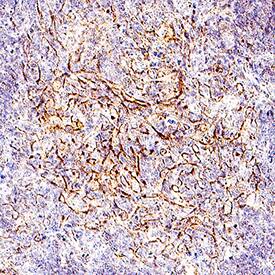Mouse TRAIL/TNFSF10 Biotinylated Antibody
R&D Systems, part of Bio-Techne | Catalog # BAF1121


Key Product Details
Species Reactivity
Validated:
Cited:
Applications
Validated:
Cited:
Label
Antibody Source
Product Specifications
Immunogen
Pro118-Asn291
Accession # P50592
Specificity
Clonality
Host
Isotype
Scientific Data Images for Mouse TRAIL/TNFSF10 Biotinylated Antibody
Detection of TRAIL/TNFSF10 in Mouse Thymus.
TRAIL/TNFSF10 was detected in immersion fixed paraffin-embedded sections of mouse thymus using Goat Anti-Mouse TRAIL/TNFSF10 Biotinylated Antigen Affinity-purified Polyclonal Antibody (Catalog # BAF1121) at 1 µg/ml for 1 hour at room temperature followed by incubation with the Streptavidin-HRP (Catalog # DY998). Before incubation with the primary antibody, tissue was subjected to heat-induced epitope retrieval using VisUCyte Antigen Retrieval Reagent-Basic (Catalog # VCTS021). Tissue was stained using DAB (brown) and counterstained with hematoxylin (blue). Specific staining was localized to the membrane. View our protocol for Chromogenic IHC Staining of Paraffin-embedded Tissue Sections.Applications for Mouse TRAIL/TNFSF10 Biotinylated Antibody
Immunohistochemistry
Sample: Immersion fixed paraffin-embedded sections of mouse thymus
Western Blot
Sample: Recombinant Mouse TRAIL/TNFSF10 (Catalog # 1121-TL)
Mouse TRAIL/TNFSF10 Sandwich Immunoassay
Formulation, Preparation, and Storage
Purification
Reconstitution
Formulation
Shipping
Stability & Storage
- 12 months from date of receipt, -20 to -70 °C as supplied.
- 1 month, 2 to 8 °C under sterile conditions after reconstitution.
- 6 months, -20 to -70 °C under sterile conditions after reconstitution.
Background: TRAIL/TNFSF10
TNF-related apoptosis-inducing ligand (TRAIL), also called apoptosis 2 ligand (Apo2L) for its similarity in sequence, structure, and function to Fas Ligand/Apo1L, is a 33‑35 kDa type II transmembrane glycoprotein of the tumor necrosis factor superfamily, designated TNFSF10 (1‑3). Mouse TRAIL cDNA encodes a 17 amino acid (aa) N-terminal intracellular domain, a 20 aa transmembrane domain and a 253 aa extracellular domain. Like most TNF family members, TRAIL is bioactive as a homotrimer (1). Unlike other TNF family members, a zinc ion complexed by human Cys 230 (mouse Cys 240) of each of the three monomers is critical for structural stability (4, 5). Either transmembrane or cysteine protease-released soluble sTRAIL induce apoptosis of many transformed cell lines, but rarely of normal cells (3, 6). Accordingly, TRAIL is suggested to have a role in tumor surveillance (1). Mice with genetically disrupted TRAIL have defective thymocyte apoptosis, creating faulty negative selection and some increased susceptibility to induced autoimmune diseases (7). In humans, TRAIL controls apoptosis of erythrocyte precursors and sTRAIL is inversely correlated with hemoglobin (1, 8). TRAIL transcripts are constitutively expressed in a variety of human (and presumably mouse) tissues and mononuclear cells (2, 3). Only one of two receptors that transduce apoptotic signals in humans is found in the mouse (TRAIL R2/DR5 but not TRAIL R1/DR4) (1). Mice express TRAIL receptors DcTRAIL R1/TNFRSF23 and DcTRAIL R2/TNFRSF22. These receptors lack death domains, but differ in structure from human regulatory receptors TRAIL R3 and TRAIL R4 (9). Osteoprotegerin has been identified in humans as a TRAIL receptor, but binding in mouse has not yet been demonstrated (1, 10). Mouse TRAIL shows 85% aa identity with rat TRAIL and 70% aa identity with human, bovine, and porcine TRAIL within the TNF homology domain (aa 118‑291).
References
- Zauli, G. and P. Secchiero (2006) Cytokine Growth Factor Rev. 17:245.
- Wiley, S.R. et al. (1995) Immunity 3:673.
- Pitti, R.M. et al. (1996) J. Biol. Chem. 271:12687.
- Bodmer, J.L. et al. (2000) J. Biol. Chem. 275:20632.
- Hymowitz, S.G. et al. (2000) Biochemistry 39:633.
- Sedger, L. M. et al. (2002) Eur. J. Immunol. 32:2246.
- Lamhamedi-Cherradi, S.E. et al. (2003) Nat. Immunol. 4:255.
- Choi, J.W. (2005) Ann. Hematol. 84:728.
- Schneider, P. et al. (2003) J. Biol. Chem. 278:5444.
- Emery, J. et al. (1998) J. Biol. Chem. 273:14363.
Long Name
Alternate Names
Gene Symbol
UniProt
Additional TRAIL/TNFSF10 Products
Product Documents for Mouse TRAIL/TNFSF10 Biotinylated Antibody
Product Specific Notices for Mouse TRAIL/TNFSF10 Biotinylated Antibody
For research use only